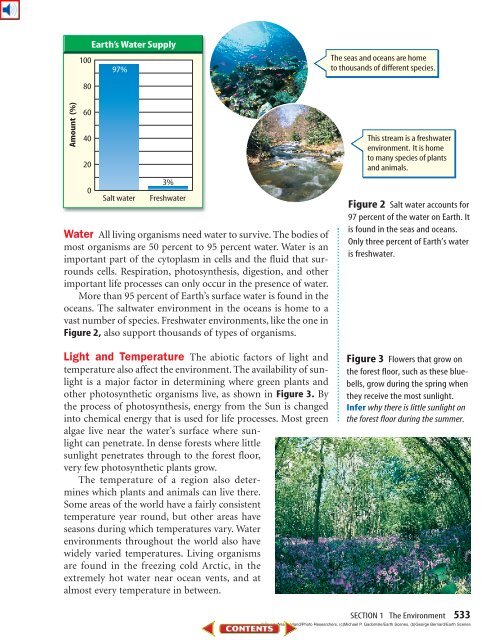Chapter 18: Interactions of Living Things
Chapter 18: Interactions of Living Things
Chapter 18: Interactions of Living Things
Create successful ePaper yourself
Turn your PDF publications into a flip-book with our unique Google optimized e-Paper software.
Amount (%)<br />
100<br />
80<br />
60<br />
40<br />
20<br />
0<br />
Earth’s Water Supply<br />
97%<br />
3%<br />
Salt water Freshwater<br />
Water All living organisms need water to survive. The bodies <strong>of</strong><br />
most organisms are 50 percent to 95 percent water. Water is an<br />
important part <strong>of</strong> the cytoplasm in cells and the fluid that surrounds<br />
cells. Respiration, photosynthesis, digestion, and other<br />
important life processes can only occur in the presence <strong>of</strong> water.<br />
More than 95 percent <strong>of</strong> Earth’s surface water is found in the<br />
oceans. The saltwater environment in the oceans is home to a<br />
vast number <strong>of</strong> species. Freshwater environments, like the one in<br />
Figure 2, also support thousands <strong>of</strong> types <strong>of</strong> organisms.<br />
Light and Temperature The abiotic factors <strong>of</strong> light and<br />
temperature also affect the environment. The availability <strong>of</strong> sunlight<br />
is a major factor in determining where green plants and<br />
other photosynthetic organisms live, as shown in Figure 3. By<br />
the process <strong>of</strong> photosynthesis, energy from the Sun is changed<br />
into chemical energy that is used for life processes. Most green<br />
algae live near the water’s surface where sunlight<br />
can penetrate. In dense forests where little<br />
sunlight penetrates through to the forest floor,<br />
very few photosynthetic plants grow.<br />
The temperature <strong>of</strong> a region also determines<br />
which plants and animals can live there.<br />
Some areas <strong>of</strong> the world have a fairly consistent<br />
temperature year round, but other areas have<br />
seasons during which temperatures vary. Water<br />
environments throughout the world also have<br />
widely varied temperatures. <strong>Living</strong> organisms<br />
are found in the freezing cold Arctic, in the<br />
extremely hot water near ocean vents, and at<br />
almost every temperature in between.<br />
The seas and oceans are home<br />
to thousands <strong>of</strong> different species.<br />
This stream is a freshwater<br />
environment. It is home<br />
to many species <strong>of</strong> plants<br />
and animals.<br />
Figure 2 Salt water accounts for<br />
97 percent <strong>of</strong> the water on Earth. It<br />
is found in the seas and oceans.<br />
Only three percent <strong>of</strong> Earth’s water<br />
is freshwater.<br />
Figure 3 Flowers that grow on<br />
the forest floor, such as these bluebells,<br />
grow during the spring when<br />
they receive the most sunlight.<br />
Infer why there is little sunlight on<br />
the forest floor during the summer.<br />
SECTION 1 The Environment 533<br />
(t)Stuart Westmorland/Photo Researchers, (c)Michael P. Gadomski/Earth Scenes, (b)George Bernard/Earth Scenes

















